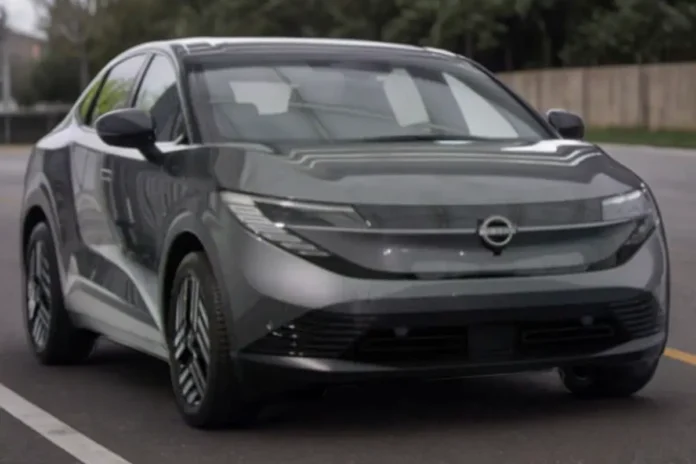The future of electric vehicles is now being reimagined with the all-new 2026 Nissan Leaf—a model that signals a bold transition from the traditional hatchback design into a sleek, sub-Ariya SUV-inspired crossover. Developed using the advanced electric Common Module Family (CMF-EV) platform, the Leaf embraces a visionary approach to design, aerodynamics, and efficiency that promises to captivate the tech-savvy and environmentally conscious driver.
Bold Design and Aerodynamics
Nissan’s latest evolution of the Leaf is a masterpiece of aerodynamic engineering and design innovation. Key design elements have been meticulously refined to achieve an impressively low drag coefficient—0.25 in markets with unique European specifications and 0.26 in other regions. Although these figures are not in the ultra-low range seen in some frontrunners, they represent the highest level of aerodynamic optimization ever achieved by Nissan.
The forward-thinking design includes practical features like an active grille shutter and flush door handles. Additionally, the smooth underbody work, intricate pixel-inspired headlamps, and a sculpted bonnet come together to offer not only a striking road presence but also enhanced energy efficiency. Even the rear profile is carefully considered: although the tailgate’s design remains under wraps, early reports hint at an innovative aerofoil effect along the fastback roofline that further improves performance on the motorway.
Interior Innovation: Panoramic Glass Roof Redefined
Step inside the new Nissan Leaf, and you’ll immediately notice the attention given to both aesthetics and functionality. One standout feature is the panoramic glass roof, equipped with an electrochromic dimming function that offers versatile light control—akin to operating a conventional sunshade but with futuristic ease. In its half-dimmed state, the roof even subtly reveals the “Leaf” branding, marrying practicality with style. Thanks to this innovative design, Nissan was able to lower the roof by 12 millimetres without sacrificing headroom, adding yet another layer of aerodynamic finesse to the vehicle.
Unparalleled Range and Efficient Charging
Nissan has engineered the 2026 Leaf to deliver confident long-range performance that reassures drivers on every journey. According to insiders, the vehicle is designed with the ambition to comfortably travel between 300 to 500 kilometers on a single charge. In addition to its extended driving range, the Leaf incorporates rapid DC fast-charging capabilities—a feature that promises a gain of more than 250 kilometers of range in just 14 minutes of charging. Such advancements demonstrate Nissan’s commitment to not only extend the practical range of their EVs but also to streamline the charging process, making long-distance journeys more accessible.
Below is an at-a-glance table summarising some of the key technical highlights of the new Nissan Leaf:
| Specification | Details |
|---|---|
| Drag Coefficient (Cd) | 0.25 (European spec)<br>0.26 (Other regions) |
| Body Style | Evolved from hatchback to a sleek sub-Ariya SUV-inspired crossover |
| Panoramic Glass Roof | Electrochromic dimming function; roof lowered by 12 mm |
| Range | 300 to 500 km between charges |
| Charging Efficiency | Gain of over 250 km in range in just 14 minutes DC fast charging |
Data are indicative and subject to final validation by production figures.
Engineering Brilliance Meets Everyday Practicality
Beyond innovation in design and technical attributes, the 2026 Nissan Leaf’s development represents Nissan’s resolute strategy to redefine highway efficiency and user convenience. As highlighted by Richard Candler, vice president of global product strategy, the vehicle has been engineered to support the demands of modern travel—providing a robust, efficient, and comfortable experience even on extended holiday journeys. Through the integration of cutting-edge technologies, such as a highly responsive charger interface and comprehensive predictive energy management systems, Nissan sets the stage for EV mobility that feels both familiar and extraordinary.
A Future Fueled by Innovation
The leap from conventional hatchback to a more modern crossover framework signals Nissan’s forward-thinking trajectory in embracing a broad spectrum of EV technology. As the new Leaf shares its platform with Nissan’s larger Ariya, its advanced system architecture ensures compatibility with future innovations and enhanced safety and driver-assist features. With plans to integrate even more smart, connected features in the near future, Nissan is firmly establishing its leadership in the rapidly evolving EV market.
Explore More on Electric Mobility
- Extended Range Technologies: Discover how emerging battery innovations enable longer journeys.
- Design Evolution: Learn about the transition from traditional EV designs to state-of-the-art aerodynamic solutions.
- Rapid Charging Systems: Read up on the latest developments in DC fast charging and connectivity.
With electric vehicles rapidly becoming mainstream, the 2026 Nissan Leaf stands out as a testament to Nissan’s commitment to innovation, sustainability, and driver-focused design. Its impressive combination of aerodynamic perfection, interior sophistication, and enhanced charging efficiency positions it as a benchmark within the electric vehicle segment—a truly positive and impactful leap forward.




